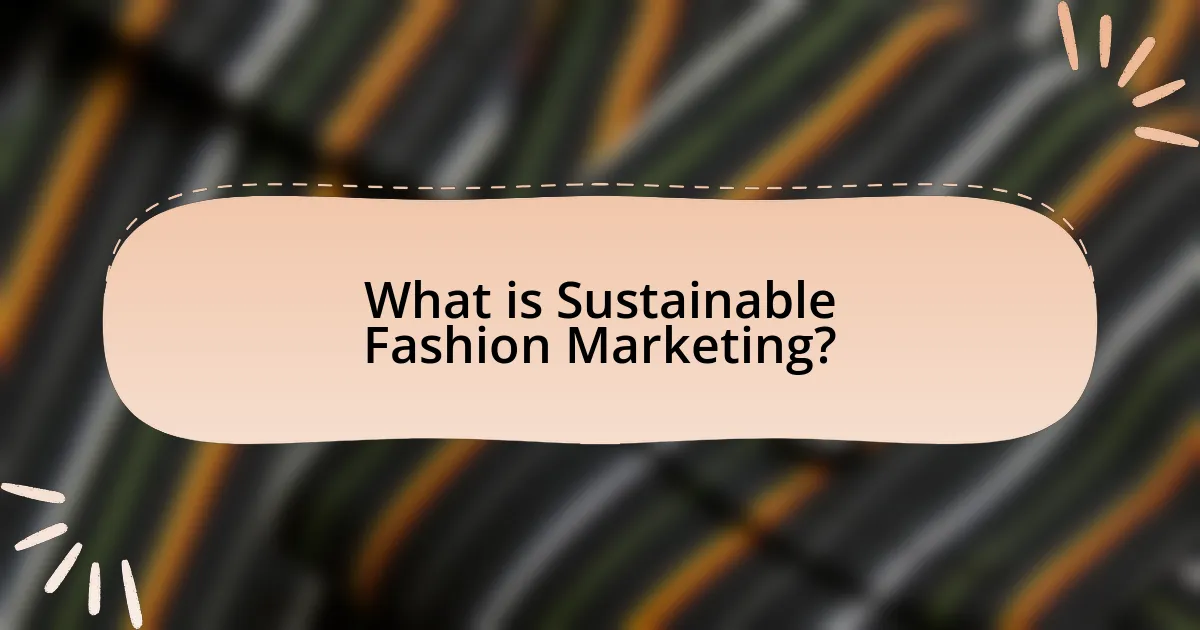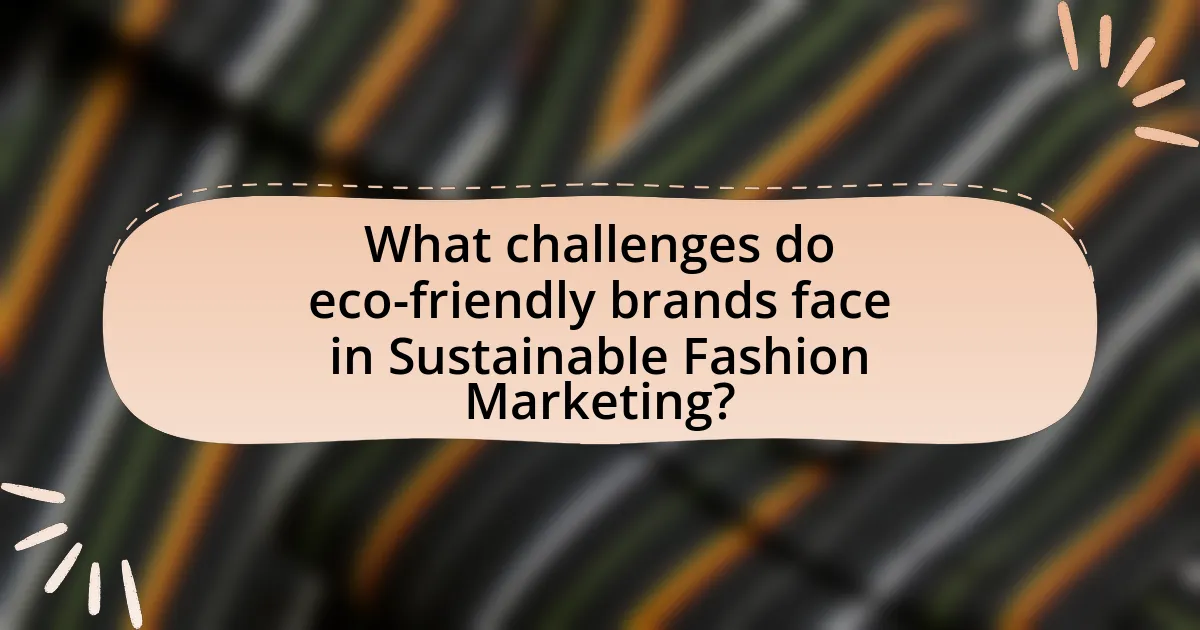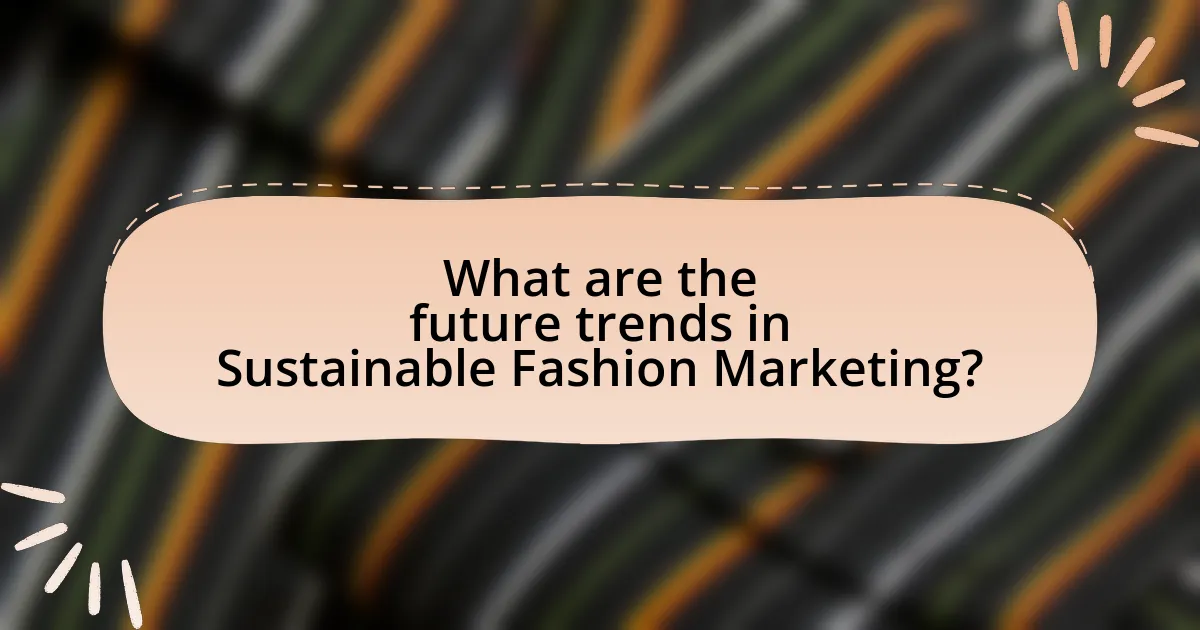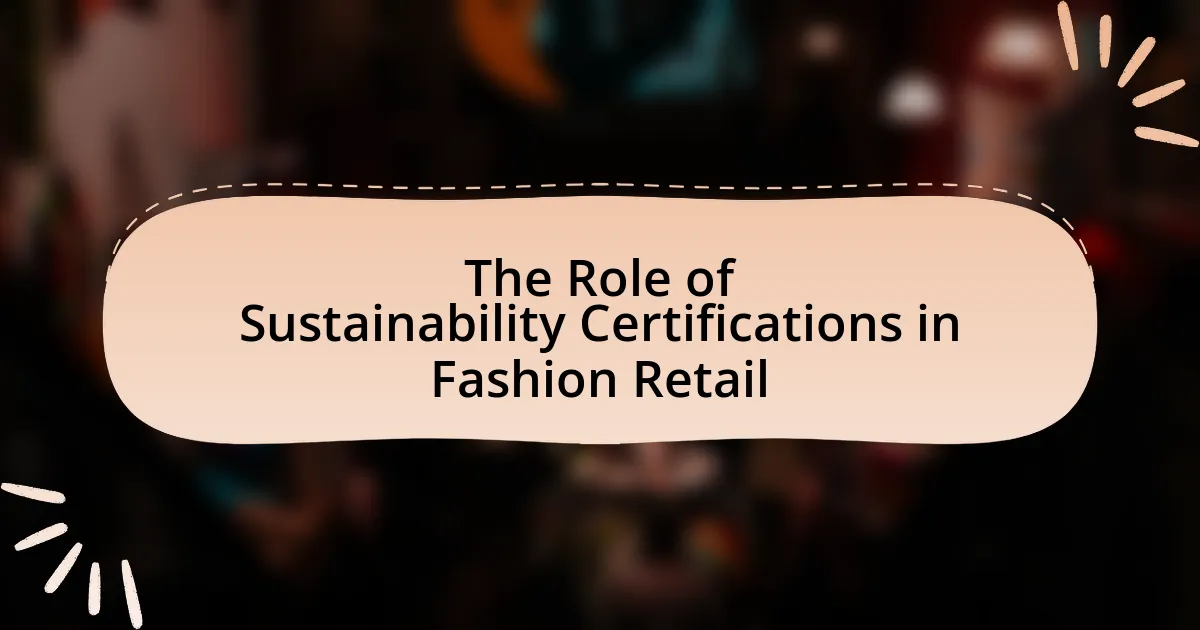Sustainable fashion marketing is the promotion of clothing and accessories produced in an environmentally and socially responsible manner, emphasizing transparency, ethical sourcing, and sustainable materials. This article explores the differences between sustainable and traditional fashion marketing, highlighting key principles such as consumer education and the importance of transparency. It discusses the role of eco-friendly brands in shaping consumer behavior, effective marketing channels, and strategies like storytelling and influencer partnerships. Additionally, the article addresses challenges faced by eco-friendly brands, including consumer skepticism and competition, while outlining future trends and practical tips for effective marketing in the sustainable fashion sector.

What is Sustainable Fashion Marketing?
Sustainable fashion marketing is the practice of promoting clothing and accessories that are produced in an environmentally and socially responsible manner. This approach emphasizes transparency, ethical sourcing, and the use of sustainable materials, aiming to reduce the fashion industry’s negative impact on the planet. According to a report by McKinsey & Company, the global fashion industry is responsible for 10% of annual carbon emissions, highlighting the urgent need for sustainable practices. By focusing on eco-friendly strategies, brands can attract consumers who prioritize sustainability, thereby fostering a more responsible fashion ecosystem.
How does Sustainable Fashion Marketing differ from traditional fashion marketing?
Sustainable fashion marketing focuses on promoting eco-friendly practices and ethical production, while traditional fashion marketing primarily emphasizes trends and consumerism. Sustainable fashion marketing highlights the environmental impact of clothing production, advocating for transparency in sourcing and manufacturing processes, which contrasts with traditional marketing’s often superficial approach to brand image and consumer appeal. For instance, a study by McKinsey & Company in 2021 revealed that 67% of consumers consider the use of sustainable materials important when making purchasing decisions, indicating a shift towards values-driven consumer behavior that sustainable fashion marketing capitalizes on.
What are the key principles of Sustainable Fashion Marketing?
The key principles of Sustainable Fashion Marketing include transparency, ethical sourcing, and consumer education. Transparency involves openly sharing information about the supply chain, production processes, and environmental impact, which builds trust with consumers. Ethical sourcing emphasizes the use of sustainable materials and fair labor practices, ensuring that products are made responsibly. Consumer education focuses on informing customers about the benefits of sustainable fashion, encouraging mindful purchasing decisions. These principles are supported by research indicating that consumers increasingly prefer brands that demonstrate social and environmental responsibility, with a 2021 survey showing that 66% of global consumers are willing to pay more for sustainable brands.
Why is consumer awareness important in Sustainable Fashion Marketing?
Consumer awareness is crucial in Sustainable Fashion Marketing because it drives informed purchasing decisions that support eco-friendly practices. When consumers understand the environmental and social impacts of their fashion choices, they are more likely to seek out brands that prioritize sustainability. Research indicates that 66% of global consumers are willing to pay more for sustainable brands, highlighting the market demand for transparency and ethical practices. This awareness not only influences consumer behavior but also compels brands to adopt sustainable practices to meet consumer expectations, thereby fostering a more responsible fashion industry.
What role do eco-friendly brands play in Sustainable Fashion Marketing?
Eco-friendly brands are pivotal in Sustainable Fashion Marketing as they embody the principles of sustainability and ethical production. These brands attract environmentally conscious consumers by promoting transparency in their supply chains and utilizing sustainable materials, which enhances brand loyalty and trust. Research indicates that 66% of global consumers are willing to pay more for sustainable brands, highlighting the market demand for eco-friendly practices. By integrating sustainability into their marketing strategies, these brands not only differentiate themselves in a competitive market but also contribute to a broader cultural shift towards responsible consumption.
How do eco-friendly brands define their target audience?
Eco-friendly brands define their target audience by identifying consumers who prioritize sustainability and environmental consciousness in their purchasing decisions. These brands typically focus on demographics such as age, income level, and lifestyle choices, targeting individuals who are often younger, more educated, and willing to invest in sustainable products. Research indicates that 73% of millennials are willing to pay more for sustainable brands, highlighting the importance of aligning marketing strategies with the values of this demographic. Additionally, eco-friendly brands often segment their audience based on psychographics, including values, attitudes, and behaviors related to environmental impact, which helps in crafting tailored messaging that resonates with their target consumers.
What marketing channels are most effective for eco-friendly brands?
Social media platforms, particularly Instagram and Facebook, are the most effective marketing channels for eco-friendly brands. These platforms allow brands to visually showcase their sustainable products and engage with a community that values environmental consciousness. According to a 2021 survey by Sprout Social, 70% of consumers are more likely to purchase from brands that actively promote their sustainability efforts on social media. Additionally, influencer partnerships on these platforms can amplify brand messages, as 49% of consumers rely on influencer recommendations when making purchasing decisions.

What strategies can eco-friendly brands use in Sustainable Fashion Marketing?
Eco-friendly brands can utilize storytelling, transparency, and community engagement as key strategies in sustainable fashion marketing. Storytelling allows brands to connect emotionally with consumers by sharing the journey of their products, highlighting sustainable practices and ethical sourcing. Transparency builds trust by openly communicating supply chain practices, material sourcing, and environmental impact, which is increasingly demanded by consumers; for instance, a 2021 survey by McKinsey found that 66% of consumers consider sustainability when making purchasing decisions. Community engagement fosters loyalty and advocacy by involving customers in sustainability initiatives, such as recycling programs or local events, which can enhance brand reputation and customer retention.
How can storytelling enhance Sustainable Fashion Marketing efforts?
Storytelling can enhance Sustainable Fashion Marketing efforts by creating emotional connections between brands and consumers. This approach allows brands to convey their values, mission, and the impact of their sustainable practices in a relatable manner. For instance, brands that share narratives about their ethical sourcing, the artisans behind their products, or the environmental benefits of their materials can foster trust and loyalty among consumers. Research indicates that 55% of consumers are more likely to purchase from brands that tell compelling stories about their sustainability efforts, highlighting the effectiveness of storytelling in driving consumer engagement and sales.
What elements make a compelling sustainability story?
A compelling sustainability story includes authenticity, emotional connection, and measurable impact. Authenticity ensures that the narrative is credible and reflects genuine practices, as consumers increasingly seek transparency in brand claims. Emotional connection engages the audience by highlighting personal stories or community benefits, making the message relatable. Measurable impact provides concrete evidence of sustainability efforts, such as reductions in carbon emissions or waste, which can be supported by data from credible sources like the Global Reporting Initiative. These elements together create a narrative that resonates with consumers and fosters trust in eco-friendly brands.
How can brands effectively communicate their sustainability initiatives?
Brands can effectively communicate their sustainability initiatives by utilizing transparent messaging, engaging storytelling, and leveraging multiple platforms. Transparent messaging involves clearly outlining the specific actions taken towards sustainability, such as using eco-friendly materials or reducing carbon emissions, which builds trust with consumers. Engaging storytelling can illustrate the brand’s journey and impact, making the initiatives relatable and inspiring. Additionally, leveraging multiple platforms, including social media, websites, and partnerships with sustainability influencers, can amplify the message and reach a broader audience. Research indicates that 66% of consumers are willing to pay more for sustainable brands, highlighting the importance of effective communication in driving consumer engagement and loyalty.
What are the benefits of influencer partnerships in Sustainable Fashion Marketing?
Influencer partnerships in sustainable fashion marketing enhance brand visibility and credibility. By collaborating with influencers who align with eco-friendly values, brands can effectively reach target audiences that prioritize sustainability. Research indicates that 49% of consumers depend on influencer recommendations for their purchasing decisions, highlighting the significant impact influencers have on consumer behavior. Additionally, influencers can create authentic content that resonates with their followers, fostering trust and encouraging sustainable purchasing habits. This synergy not only amplifies brand messages but also promotes a culture of sustainability within the fashion industry.
How do influencers impact consumer perceptions of eco-friendly brands?
Influencers significantly shape consumer perceptions of eco-friendly brands by leveraging their credibility and reach to promote sustainable practices. Research indicates that 70% of millennials are influenced by social media when making purchasing decisions, particularly regarding eco-friendly products. Influencers often share personal experiences and endorsements, which enhance trust and relatability, making consumers more likely to view eco-friendly brands positively. Additionally, studies show that influencer marketing can increase brand awareness by up to 11 times, further solidifying the perception of eco-friendly brands as desirable and trustworthy.
What criteria should brands consider when selecting influencers?
Brands should consider the influencer’s alignment with their values and target audience when selecting influencers. This alignment ensures that the influencer’s content resonates with the brand’s message and appeals to the intended demographic. Additionally, brands should evaluate the influencer’s engagement rates, as higher engagement often indicates a more active and interested audience. According to a study by Influencer Marketing Hub, influencers with engagement rates above 3% are generally more effective in driving consumer action. Furthermore, brands should assess the influencer’s authenticity and credibility, as consumers are increasingly drawn to genuine voices in the sustainable fashion space. Research from the Digital Marketing Institute shows that 70% of consumers prefer to buy from brands that are transparent and authentic. Lastly, brands should consider the influencer’s reach and platform, ensuring they utilize channels that effectively target their desired market.

What challenges do eco-friendly brands face in Sustainable Fashion Marketing?
Eco-friendly brands face significant challenges in Sustainable Fashion Marketing, primarily due to consumer skepticism and high competition. Many consumers question the authenticity of eco-friendly claims, leading to a lack of trust in brands that market themselves as sustainable. According to a 2021 survey by McKinsey, 66% of consumers expressed concerns about greenwashing, where brands exaggerate their environmental efforts. Additionally, eco-friendly brands often compete with fast fashion retailers that offer lower prices and faster production times, making it difficult to attract price-sensitive consumers. This competition is compounded by the need for eco-friendly brands to educate consumers about the benefits of sustainable practices, which can require substantial marketing resources.
How can eco-friendly brands overcome skepticism from consumers?
Eco-friendly brands can overcome skepticism from consumers by providing transparent information about their sourcing, production processes, and environmental impact. Transparency builds trust; for instance, brands that disclose their supply chain details and sustainability certifications, such as GOTS or Fair Trade, demonstrate accountability. Research indicates that 66% of consumers are willing to pay more for sustainable brands when they understand the benefits, highlighting the importance of clear communication. Additionally, engaging consumers through storytelling about the brand’s mission and values can foster emotional connections, further reducing skepticism.
What strategies can be employed to build trust with consumers?
To build trust with consumers, eco-friendly brands should prioritize transparency in their practices. This includes openly sharing information about sourcing, production processes, and the environmental impact of their products. For instance, a study by Nielsen found that 66% of consumers are willing to pay more for sustainable brands, indicating that transparency can enhance consumer trust and loyalty. Additionally, brands can engage in consistent communication through social media and customer feedback channels, fostering a sense of community and responsiveness. By demonstrating accountability and commitment to sustainability, brands can effectively build and maintain trust with their consumers.
How can brands effectively address greenwashing concerns?
Brands can effectively address greenwashing concerns by ensuring transparency in their sustainability claims and providing verifiable evidence of their eco-friendly practices. For instance, brands should disclose detailed information about their supply chain, sourcing materials, and production processes, allowing consumers to assess the authenticity of their sustainability efforts. Research from the Harvard Business Review indicates that companies that prioritize transparency and engage in third-party certifications, such as Fair Trade or Global Organic Textile Standard, can significantly enhance consumer trust and mitigate accusations of greenwashing. By adopting these practices, brands not only demonstrate their commitment to sustainability but also build credibility with environmentally conscious consumers.
What are the common pitfalls in Sustainable Fashion Marketing?
Common pitfalls in Sustainable Fashion Marketing include greenwashing, lack of transparency, and failure to engage consumers effectively. Greenwashing occurs when brands exaggerate or falsely claim their sustainability efforts, leading to consumer distrust; for instance, a 2021 study by the European Commission found that 42% of green claims made by companies were misleading. Lack of transparency can alienate consumers who seek authentic information about sourcing and production practices, as evidenced by a 2020 survey from McKinsey, which revealed that 66% of consumers expect brands to be transparent about their supply chains. Lastly, failing to engage consumers through storytelling and education can result in missed opportunities to build brand loyalty, as research from Nielsen indicates that 73% of millennials are willing to pay more for sustainable products when they understand the brand’s story.
How can brands avoid miscommunication about their sustainability efforts?
Brands can avoid miscommunication about their sustainability efforts by ensuring transparency and clarity in their messaging. Clear communication involves providing specific details about sustainability initiatives, such as sourcing materials, production processes, and environmental impact metrics. For instance, a study by the Global Fashion Agenda indicates that 66% of consumers expect brands to be transparent about their sustainability practices. By using straightforward language and avoiding jargon, brands can foster trust and understanding among consumers, thereby reducing the risk of misinterpretation.
What role does transparency play in successful marketing strategies?
Transparency is crucial in successful marketing strategies as it builds trust and credibility with consumers. In the context of sustainable fashion marketing, brands that openly share their sourcing, production processes, and environmental impact foster a stronger connection with eco-conscious consumers. Research indicates that 94% of consumers are likely to be loyal to a brand that offers complete transparency, as highlighted in the 2020 Global Consumer Insights Survey by PwC. This trust not only enhances brand loyalty but also encourages word-of-mouth promotion, which is vital for growth in the competitive sustainable fashion market.

What are the future trends in Sustainable Fashion Marketing?
Future trends in Sustainable Fashion Marketing include increased transparency, the use of technology for sustainability tracking, and a focus on circular fashion. Brands are expected to adopt transparent supply chains, allowing consumers to trace the origins and environmental impact of their products. According to a 2021 McKinsey report, 67% of consumers consider sustainability when making a purchase, indicating a growing demand for brands to demonstrate their eco-friendly practices. Additionally, advancements in technology, such as blockchain, will enable brands to provide real-time data on sustainability efforts, enhancing consumer trust. Circular fashion, which emphasizes recycling and reusing materials, is also gaining traction, with a projected market growth of 9.7% annually through 2027, as reported by the Ellen MacArthur Foundation. These trends reflect a shift towards more responsible consumer behavior and brand accountability in the fashion industry.
How is technology shaping the future of Sustainable Fashion Marketing?
Technology is significantly shaping the future of Sustainable Fashion Marketing by enabling brands to utilize data analytics, artificial intelligence, and blockchain for transparency and consumer engagement. Data analytics allows brands to understand consumer preferences and trends, leading to more targeted marketing strategies that promote eco-friendly products. Artificial intelligence enhances personalization in marketing campaigns, making it easier for consumers to connect with sustainable brands. Blockchain technology provides traceability in the supply chain, ensuring that consumers can verify the sustainability claims of products, which builds trust and loyalty. For instance, a report by McKinsey & Company highlights that 66% of consumers are willing to pay more for sustainable brands, indicating that technology-driven transparency can directly influence purchasing decisions.
What innovations are emerging in sustainable materials and production processes?
Innovations in sustainable materials and production processes include the development of bio-based textiles, such as those made from organic cotton, hemp, and recycled polyester, which significantly reduce environmental impact. Additionally, advancements in production techniques, like 3D printing and digital textile printing, minimize waste and energy consumption. For instance, a study by the Ellen MacArthur Foundation highlights that using recycled materials can reduce carbon emissions by up to 70% compared to virgin materials. Furthermore, innovations in circular economy practices, such as take-back programs and upcycling, are gaining traction, promoting resource efficiency and reducing landfill waste.
How can brands leverage data analytics for better marketing strategies?
Brands can leverage data analytics to enhance marketing strategies by utilizing consumer insights to tailor their messaging and product offerings. By analyzing data from customer interactions, purchase history, and social media engagement, brands can identify trends and preferences that inform targeted campaigns. For instance, a study by McKinsey & Company found that companies using data-driven marketing strategies can achieve five to eight times the ROI on their marketing spend. This demonstrates that effective use of data analytics not only improves customer engagement but also drives sales and brand loyalty in the competitive sustainable fashion market.
What practical tips can eco-friendly brands implement for effective marketing?
Eco-friendly brands can implement practical marketing tips such as emphasizing transparency in sourcing and production processes. By clearly communicating their sustainable practices, brands can build trust with consumers who prioritize ethical consumption. Research indicates that 66% of global consumers are willing to pay more for sustainable brands, highlighting the importance of showcasing eco-friendly initiatives. Additionally, utilizing social media platforms to engage with environmentally conscious audiences can enhance brand visibility and foster community. Collaborating with influencers who advocate for sustainability can further amplify marketing efforts, as 49% of consumers depend on influencer recommendations for purchasing decisions.
How can brands create engaging content that resonates with their audience?
Brands can create engaging content that resonates with their audience by understanding their values and preferences, particularly in the context of sustainable fashion. Research indicates that 66% of consumers are willing to pay more for sustainable brands, highlighting the importance of aligning content with eco-conscious values. By utilizing storytelling that emphasizes the brand’s commitment to sustainability, showcasing behind-the-scenes processes, and featuring customer testimonials, brands can foster a deeper emotional connection. Additionally, incorporating interactive elements such as polls or quizzes can enhance engagement, as 70% of consumers prefer brands that encourage participation. This approach not only captures attention but also builds community around shared values, making the content more relatable and impactful.
What best practices should be followed for social media marketing in sustainable fashion?
Best practices for social media marketing in sustainable fashion include creating authentic content that highlights eco-friendly practices, engaging with the audience through storytelling, and utilizing visual platforms to showcase sustainable products. Authentic content builds trust; for instance, brands like Patagonia share their environmental impact reports, demonstrating transparency. Engaging storytelling can connect emotionally with consumers, as seen in campaigns that feature the artisans behind the products. Visual platforms like Instagram are effective for showcasing the aesthetics of sustainable fashion, with studies indicating that posts with high-quality images receive 94% more views. Additionally, collaborating with influencers who align with sustainability values can amplify reach and credibility.




